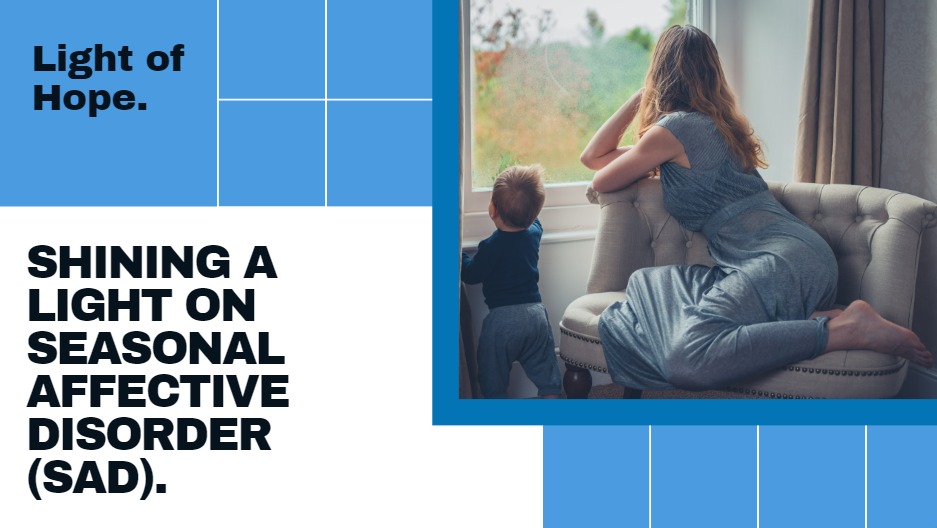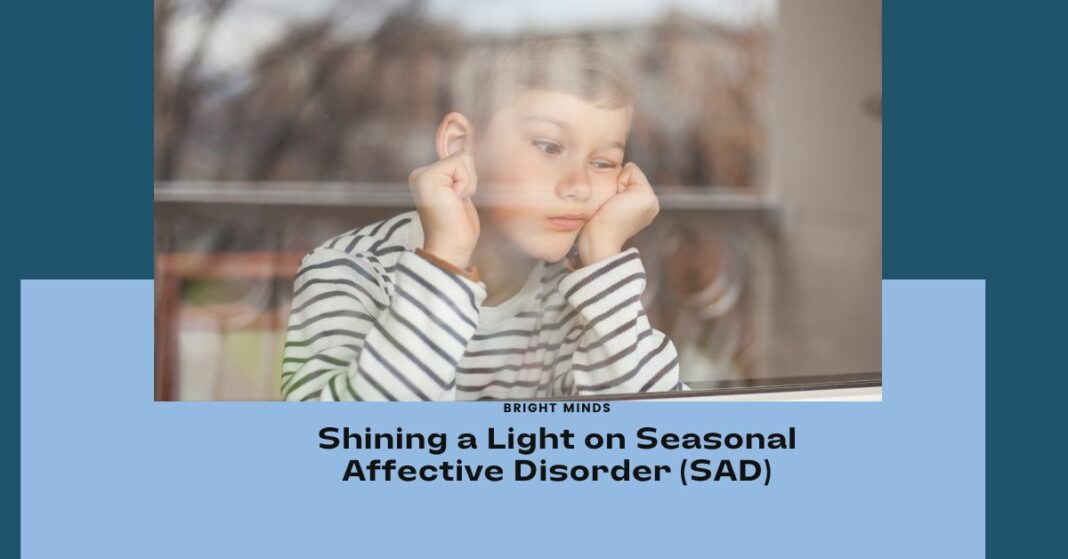What’s This SAD Thing, Anyway?

Seasonal Affective Disorder (SAD) isn’t a mysterious secret society or an underground cult. It’s actually a type of depression that shows up like an uninvited guest when the cold weather and dark days roll in.
SAD by the Numbers
Before you start blaming the winter wonderland for your mood swings, know that SAD is pretty common. We’re talking about millions of people. So, you’re definitely not alone in this winter struggle.
The Mood-Munching Monster
This SAD creature isn’t just about feeling a bit down. It can seriously mess with your mental health. But don’t worry; we’re here to shed light on this dark situation and show you how to tackle the mood-munching monster head-on.
Also Read: How to Lower BMI
Understanding SAD
Seasonal Shenanigans and Body Buzzkill
Imagine your body as a moody teenager that gets all grumpy during winter. SAD is like its rebellious phase, brought on by seasonal changes and some biological factors. It’s not just for show; there’s some science behind it.
Light: The Unsung Hero (or Villain)
Light exposure is the ultimate player in the SAD game. The less sunshine you soak up, the more likely you are to join the SAD club. We know it’s tough to believe, but your desk lamp just won’t cut it.
Common Signs of SAD: Feeling Like a Hibernating Bear
SAD brings a bunch of symptoms to the winter party. Think fatigue, gloomy mood, and a craving for carbs. It’s like your body’s way of saying, “Why can’t I just hibernate like a bear?”
Winter Blues vs. SAD: Spot the Difference
The line between winter blues and full-on SAD can be as thin as a snowflake. Knowing the difference is crucial. If you find yourself debating whether you’re just chilly or truly SAD, we’ve got you covered.
Diagnosing SAD
The Importance of Seeking Pro Help
Winter Woes Are Real: Before self-diagnosing or trusting Dr. Google, remember that SAD isn’t just a case of the “winter blues.” It’s a real thing, and it can mess with your groove. So, when in doubt, seek out a healthcare pro. They’re not mind-readers, but they’re close enough!
No DIY Diagnoses: Sure, the internet’s got answers to everything, but it’s not your go-to doc for diagnosing SAD. Don’t just rely on a checklist you find online. Chat with a pro who knows their stuff.
Diagnostic Criteria
What’s the Checklist?: Diagnosing SAD isn’t a guessing game. There’s a set of criteria that healthcare wizards follow. It’s like a puzzle, and each piece (or symptom) plays a role.
Assessments Galore: Your healthcare hero might use questionnaires and assessments to figure out if SAD is your mood-munching monster. It’s all part of their plan to get you back to the sunshine-loving you.
Coping with SAD
Lifestyle Adjustments
- Daily Routines Matter: When the sun hides, routines become your best friend. They provide structure and help ward off the mood monsters. Stick to a schedule, even if it means scheduling “dance like nobody’s watching” time.
- Get That Booty Moving: Exercise is like a magic potion that your body makes for itself. It boosts mood and energy. Plus, if you do it outside, you get bonus points for defying the winter chill.
- Food Fuel: Your belly is a mood ring, but it doesn’t need to change color with the seasons. Balanced nutrition keeps your mood steady. So, load up on those veggies and not-so-occasional chocolate chip cookies.
Light Therapy
- Lightboxes to the Rescue: Light therapy involves hanging out with a lightbox that mimics sunlight. Just don’t expect it to share your fries. These boxes can help your brain think it’s summer, even in the darkest depths of winter.
- Dos and Don’ts: Don’t let your enthusiasm blind you. Use light therapy as directed; more isn’t always merrier. And no, you can’t get a tan from it, so don’t try.
Mindfulness and Cognitive Behavioral Therapy
- Strategy Time: Mindfulness and CBT are like secret weapons against SAD. They help you handle the mood swings, anxiety, and grumpiness. It’s like having a shield and a sword in your emotional arsenal.
- Techniques for Zen Vibes: These techniques help you keep the winter gloom at bay. From deep-breathing exercises to positive thinking, they’re your ticket to a happier winter wonderland.
Also Read: Worst Diets
Treatment Options
Medication
Antidepressant Overview: Imagine these as little sunshine pills. Antidepressants can help, but they aren’t one-size-fits-all. Your doc will need to play detective to find the right one. It’s like the “Sherlock Holmes” of medications.
Doc’s Orders: Your healthcare provider is like the wise guru. They’ll give you the lowdown on which meds could work for you. Always consult before you self-prescribe. You might think you’re a medical prodigy, but let’s not put your expertise to the test here.
Combining Therapies
Multi-Pronged Attack: SAD is a formidable foe, and tackling it from multiple angles is your secret weapon. Combining therapies, like a superhero dream team, can often be the game-changer.
Tailored Treatment: Like a well-fitted suit, a personalized treatment plan is the way to go. It’s designed to match your unique quirks and needs. Discuss your options with your healthcare team; they’re there to make you shine, even in the darkest of winters.
Seasonal Affective Disorder and Your Environment
Tips for creating a SAD-friendly environment
- Light up Your Life: Let there be light, and we’re not talking supernatural! Maximize natural light by opening those blinds during the day. You might not become a sunflower, but it helps.
- Decorate Like a Pro: Your space, your rules. Add a splash of color to lift your spirits. Go ahead and unleash your inner decorator. It’s your home, not a fancy art gallery.
- Green Friends: Houseplants are like nature’s minions. They bring life and oxygen to your indoor kingdom. Plus, they don’t talk back!
The impact of daylight and interior lighting
- Daylight Dance: Bask in the sun whenever you can. Even if it’s the “I’m in bed with my laptop” kind of basking. But don’t overdo it. We’re going for mood improvement, not turning into a lobster.
- Let’s Talk Bulbs: Say goodbye to dingy, dungeon-like lighting. Swap out those cave-worthy bulbs for brighter, whiter, and more energy-efficient options. Your room will thank you.
Preventing SAD
Strategies for those at risk
- Get Out and Play: Whether it’s sledding, skiing, or snowball fights, embrace winter activities. You’re not too old for snow angels!
- Mood-Boosting Nutrition: Don’t underestimate the power of a good meal. Load up on mood-enhancing foods. They won’t make you a gourmet chef, but they could keep the blues at bay.
- Social Hibernation? Not Cool: Hibernate like a bear in your cozy cave? Bad idea. Socialize, even if it’s just virtually. Human contact is like chicken soup for the soul, even if it’s chicken soup over Zoom.
Year-round wellness practices
- Exercise Beyond the Snow: When the snow melts, don’t stash your sneakers. Regular exercise keeps your mood elevated. It’s like free therapy but with fewer couches.
- Prioritize Self-Care: Self-care isn’t a buzzword; it’s your secret weapon. Read a book, take a bubble bath, meditate, or binge-watch that show you pretend to hate. No judgment here.
- Catch Those Zzzs: Sleep is your BFF. Create a sleep haven, and stick to a routine. You’ll be amazed at what a good night’s sleep can do.
Also Read: Mastering Incline Push-Ups
In Crux
Feeling like a sun-starved vampire during winter? Fear not! You’ve just completed the SAD survival guide. Now, let’s wrap things up with a cheerful bow.
Remember, it’s not a sign of weakness to ask for help. Professionals are there to guide you through the darkest of winter tunnels. You’re the star, and they’re your trusty sidekick.
Managing Seasonal Affective Disorder isn’t a one-size-fits-all ordeal. It’s your journey, your story. With the right tools and a splash of determination, you can keep the blues at bay, even when the snow is piling up. So, get out there, embrace the winter wonderland, and remember, the sun will shine again!
Thank you for joining us on this fitness journey! We hope you found our blog insightful and inspiring. Our aim is to provide you with valuable information, expert advice, and motivational content to support you in your wellness endeavors.
- Beauty of Restorative Sleep
- Love in Motion: Uniting Hearts through Yoga for Couples
- Distinguishing Abstinence from Celibacy
FAQs about Seasonal Affective Disorder
How common is SAD, and does it have a significant impact on mental health?
SAD is more prevalent than you might think. It affects millions of people worldwide. While it's not a life-threatening condition, it can certainly make life a bit more challenging during the winter months. So yes, it can have a noticeable impact on mental health.
What causes SAD?
SAD is like a complicated recipe with a pinch of season changes and a dash of biological factors. When sunlight decreases in the fall and winter, it messes with your internal clock and serotonin levels, which can lead to the winter blues.
What are the typical symptoms of SAD, and how can I differentiate it from just feeling a bit down during winter?
Symptoms of SAD include low energy, oversleeping, changes in appetite, and a craving for carbs. It's like your body is staging a protest against winter. To differentiate it from a mild case of winter blues, consider how intensely and consistently these symptoms affect your daily life.
Should I see a healthcare professional if I suspect I have SAD?
Absolutely! If you're singing the winter blues and it's more than just a passing tune, consult a healthcare professional. They can help confirm your diagnosis and recommend the best treatment options for your unique situation.
What's this light therapy I've heard about, and does it really work?
Light therapy, or using a lightbox, is like bringing a piece of the sun into your home. It's designed to mimic natural sunlight and has been shown to be effective in treating SAD for many folks. Just don't use it as an excuse to wear sunglasses indoors.
Can lifestyle adjustments help combat SAD?
Indeed, they can! Simple things like maintaining a routine, exercising regularly, and eating a balanced diet can help lift your spirits and keep those SAD monsters at bay. You're not chasing happiness; you're just luring it in.
What is cognitive-behavioral therapy, and how can it assist with SAD?
Cognitive-behavioral therapy (CBT) is like a mind gym. It equips you with tools to manage SAD symptoms by changing your thought patterns and behaviors. So, rather than dwelling on the snowstorm outside, you focus on cozy evenings and hot chocolate.
Are there medications available to treat SAD?
Yes, there are! Antidepressants can help some people tackle SAD. However, you should consult a healthcare provider to see if they're the right path for you. No, they won't come with a "No Winter Blues" guarantee, but they can make life a bit sunnier.
How can I prevent SAD in the first place?
While you can't entirely prevent SAD, you can reduce your risk by embracing year-round wellness practices. Keep a healthy lifestyle, stay active, and expose yourself to natural light when possible. But remember, even if winter gets you down, there's a light at the end of the snow-covered tunnel.

Meet Pradeep Singh, your go-to guide for all things fitness, health, and motivation. With over 7 years in the field, Pradeep brings a blend of expertise and real-world experience to his writing. From workout tips to healthy living insights, he simplifies complex topics, making fitness accessible for everyone. His authentic approach and genuine passion aim to inspire and support your wellness journey. Get ready to embark on a path to a healthier lifestyle with Pradeep as your trusted companion and motivator.






















